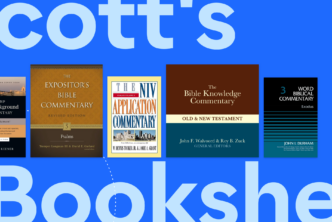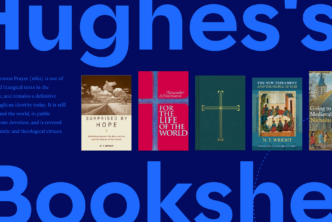Nijay K. Gupta, professor of New Testament at Northerm Seminary (PhD, University of Durham), contributed a series on biblical commentaries on the Pauline epistles. Dr. Gupta has written three commentaries (Colossians, 1–2 Thessalonians, Lord’s Prayer), and he has another commentary in production (Philippians, Cambridge University Press, co-written with Michael F. Bird), and is currently writing the Galatians volume for the Story of God commentary series. You can follow Gupta’s personal blog @ www.cruxsolablog.com
Paul’s letter to the Romans is one of the most discussed pieces of literature in all of history. This is a testimony both to Paul’s influence as well as to the impact Romans itself has had on Christianity and Western history. Here is a breakdown of some of the best commentaries for Romans. Look for the “Own It” suggestion at the end of most categories!
Don’t Neglect “Older” Commentaries
I often see on social media that pastors are eager to buy the “latest” Christian leadership book or commentary. I get it. I also get giddy for new books, but there are some classic modern and pre-critical commentaries on Romans that are invaluable.
In this first post in the series, I will just make a blanket statement saying that it is always helpful to look at St. John Chrysostom’s homilies on biblical texts, which often feel like devotional/sermon-like commentaries. Also, where possible check out Augustine, Theodoret of Cyrus, Theodore Mopsuestia, and Ambrosiaster. A helpful resource is IVP’s Ancient Christian Commentary on Scripture series. Of the Reformation writers, I always consult Calvin (even though I am “Wesleyan!”), who wrote spectacular commentaries.
When it comes to important Romans commentaries written before 1980, Karl Barth wrote a brilliant Romans commentary (ET 1968), courting controversy with his focus on the theological interpretation of the letter. At that time, most commentaries were primarily historical notes and word studies, but Barth dropped this bomb of a commentary in their midst. It is not stuffy or esoteric, but eminently readable and inspirational. Less methodically controversial, but equally volatile, is the commentary by German Lutheran NT theologian Ernst Kasemann.
Technical Commentaries
(in-depth engagement with Greek text; for scholars and pastors with advanced training in language and exegetical methods)
Just by way of warning, to make these blog posts readable, my comments are selective, not comprehensive. There have been over 100 Romans commentaries published in the last 25 years!
James D. G. Dunn (WBC). This two-volume set offers a “New Perspective” interpretation of Romans, but Dunn’s verse-by-verse study of the Greek text showcases his exegetical and theological brilliance far beyond the singular NPP/OPP debate. (If you want a quick guide to the NPP, see Nijay Gupta, “Paul, New Perspective on” Lexham Bible Dictionary)
Robert Jewett (Hermeneia). Famously, Jewett worked on this commentary for a quarter of a century. His expertise is in socio-historical contextualization of biblical texts. The series is critically acclaimed—and this volume is very important indeed—but pastors should know the Hermeneia series is self-described as non-confessional and does not generally take interest in modern application (though there are occasional exceptions).
Richard Longenecker (NIGTC). This is a massive in-depth study of the Greek text of Romans. Longenecker is widely respected and known to be fair and balanced in his exegetical decisions. Longenecker sticks close to focusing on interpreting the text and not crossing swords with other commentators or Pauline theologians much.
Douglas Moo (NICNT). Now in its second edition, this is widely-known and appreciated as a carefully researched commentary with attention to the Greek text, but also offers Moo’s perspective on key issues in Pauline theology. Moo presents and defends a traditional/Reformational approach to Romans.
Own it: Dunn
Semi-Technical Commentaries
(some interaction with the Greek text; aimed at pastors)
C. K. Barrett (BNTC). If you haven’t read Barrett, he is wise, articulate, and fair. He is from a bit of an earlier generation of scholarship, so he does not weigh in on 21st century theological debates. Still, his sermon-like writing style is winsome and inspirational.
Frank Matera (Paideia).Matera has excellent exegetical sensibilities and this series includes a nice (albeit brief) set of theological reflections at the end of each segment of commentary. If you have trouble following Paul’s flow of thought in Romans, Matera comes to the rescue.
N. T. Wright (NIB). At 700 pages, this can seem like an intimidating commentary, but Wright has an engaging writing style. In some ways he represents the New Perspective on Paul, but the best way to explain it is this: “Wright is Wright” (often brilliant, but not always right).
Craig Keener (NCCS). Keener’s expertise is putting Paul’s writings in ancient context. He is objective at all times (perhaps to a fault! Get angry, Doc!). He is a great counter-balance to both Moo and Wright, like a scholarly referee. ????
Own it: Wright
(Hmmmm, I have recommended commentaries by Dunn, Barrett, and Wright, all of whom were living near Durham while I was there—what a strange coincidence.)
Non-Technical Commentaries
(easy to read for laypeople)
Michael Bird (Story of God). It’s just fun to read MFB. He’s clever, he’s witty, and has many flashes of interpretive brilliance. He often bridges OPP and NPP and he brings a non-American (Australian) perspective to the study of Paul.
Paul Achtemeier (Interpretation). This is not quite a commentary, but almost like a series of theological lectures on Romans. Still, Achtemeier is a deep thinker and great communicator representing a more mainline perspective.
Douglas Moo (NIVAC). This is a much smaller and more devotional version of his big commentary. This series includes ample reflection on modern application.
Own it: Bird
Hidden Gems
(these are recommendations that you will get from me, but often overlooked or forgotten by others)
J. P. Burns (The Church’s Bible). Burns offers excerpts and explanations of how the Church Fathers read and interpreted Romans.
Where are the women and people of color?
Yes, I noticed that too. In the arena of Romans commentaries, sadly there is not much out there in print, but that is changing. Beverly Gaventa is writing what I expect will be the new elite commentary on Romans. The prospect of reading women and POC is much better in other Pauline texts (for reasons I cannot fully explain).
I imagine Pauline scholarship is going to look a lot different in ten years, especially thanks to increasing support for women/POC in doctoral programs and tenured jobs, as well as intentional interest from academic publishers.


















